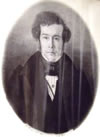
|
Women and Independence in Latin America An exploration of women's involvement in the Latin American Wars of Independence |

|

|
Women and Independence in Latin America An exploration of women's involvement in the Latin American Wars of Independence |

|
Click on one of the images below to see the full-size image
 Esteban Echeverría |
 Esteban Echeverría |
 Esteban Echeverría |
Gender:Male
Ethnic origen: White
Events:
| 1805 | - | Tucumán | - | Not applicable | - | He was born in Tucumán on 2 September 1805. |
| 1825 | - | Buenos Aires | - | Patriot | - | He returned here in 1825. |
| 1825-1830 | - | Paris | - | Patriot | - | He was in Paris (Sorbonne) from 1825-1830. |
| 1837 | - | Buenos Aires | - | Patriot | - | He led Sastra's Salón Literario. |
| 1838 | - | Montevideo | - | Patriot | - | He went into exile in Montevideo. |
| 1838 | - | Montevideo | - | Patriot | - | He established La Joven Argentina with Alberdi. |
| 1851 | - | Montevideo | - | Patriot | - | He died on 11 or 19 January 1851. |
Connections:
Anti-indigenous/ anti-blackBiography:
A poet, one of the “Generation of 37”, he was born in Tucúman, Argentina, in 1805, he was friends with Alberdi. He was invited by Sastre to lead the Salón Literario in 1837 (he was then Argentina’s leading poet).
He lived in France from 1825-30 where he became interested in the Romantic author Lamartine. Katra perceives “explicit racial overtones” in Echeverría’s “El matadero” and in La Cautiva, the Europeanised Brian and his “virginal companion, María”, confronted by “uncivilized Indian hoards” (Katra, 31-32,53).
In 1837, Sastre, Alberdi and Juan María Gutierrez founded the Salón del ’37, a Buenos Aires based salón literario. This was also known as Marcos Sastre’s Salón Literario. It was composed of a group of young intellectuals who were dissatisfied with Rosas’s infiltration/ control of the University. They met in Sastre's library to design a project of national conscience and liberal reforms to bring about Rosas’s downfall. It had about 50 members, among them Vicente López, and Esteban Echeverría. They also devised the cultural programme implemented by Sarmiento. (Denegri, 120.) It lasted only for a few months due to Sastre’s approval of Rosas for having brought order and peace to Argentina. (Katra, 48.)
On 23 June 1838, together with Alberdi, he established La Joven Argentina, a group of 35 young men who were opposed to Rosas. Their “code” (15 symbolic faith words of the young generation) was published in El Iniciador, Montevideo, in January 1839 and in El Nacional, Montevideo, in February 1839. This was later revised by Echeverría and published in 1846 as El dogma socialista an 86 page essay. The group was committed to cultural and political activism to overthrow Rosas. (Katra, 61-62.)
He was enamoured with Mariquita Sánchez, who was 20 years his senior, and wrote poems discussing relationships between young men and older women. Sáenz Quesada believes that they were probably spiritual and physical lovers. He died on 11 January 1851 in Montevideo. His friend Vicente Fidel López was with him and organised his papers. (Saenz Quesada, 152-155, 221-229).
Coester claims that his Elvira, 1832, introduced romanticism to Argentina. He returned from Europe in 1830. His book of poems, Los consuelos, includes "El y ella" a love dialogue that was popular with women. In 1837 he published Las Rimas, short poems plus one long one, "La cautiva", the story of a white woman, María, who was captured by Indians. She managed to kill the Indian cacique and save her wounded husband. She helps him to a river and swims across carrying him on her back, but he dies the following day from fever. She crosses the pampa alone and meets some soldiers who are out looking for her. She then learns that her only son has been killed and she herself dies. In June 1837, Echeverría founded "La Asociación de Mayo", a secret society to defeat Rosas. He wrote a pamphlet, El Dogma Socialista, which was according to Coester, more democratic than socialist. Rosas persecuted members of the society, Echeverría went to the country, and then joined General Lavalle in Montevideo. He continued to write poems, not taking part in the fighting because he "suffered severely from an affliction of the heart". He was a member of the Asociación de Mayo. (Coester, 106-111, 123)
Franco calls him as "the spoiled son of a widowed mother". He read Montesquieu, Pascal and Chateaubriand in France. He returned to Buenos Aires in 1830 and attended literary society meetings and tertulias before Rosas came to power. She describes his poem "La cautiva" as a reverse of the usual Romantic ideal of salvation in the countryside - Echeverría's pampa is barbaric, the elements are hostile and the Indians, savage. (Franco, 38-42)
Davies provides a critical analysis of some of his work; in particular gender in La Cautiva, 'El Matadero', El Dogma Socialista, and Manual de Enseñanza Moral. (Davies et al, 76-99)
He died in 1851.
References:
Anderson Imbert, Enrique (1954) Historia de la literatura hispanoamericana, Tomo I, La Colonia cien años de República
Coester, Alfred (1919) The Literary History of Spanish America
Davies, Catherine, Brewster, Claire and Owen, Hilary (2006) South American Independence. Gender, Politics, Text
Denegri, Francesca (1996) El Abanico y la Cigarerra: La primera generación de mujeres ilustradas en el Perú, 1860-1895
Franco, Jean R.O. Jones (editor). (1973) Spanish American Literature Since Independence
Katre, William H. (1996) The Argentine Generation of 37, Echeverría, Alberdi, Sarmiento, Mitre
Robinson, John L. (1982) Bartolomé Mitre, Historian of the Americas
Sáenz Quesada, María (1996) Mariquita Sánchez, Vida política y sentimental